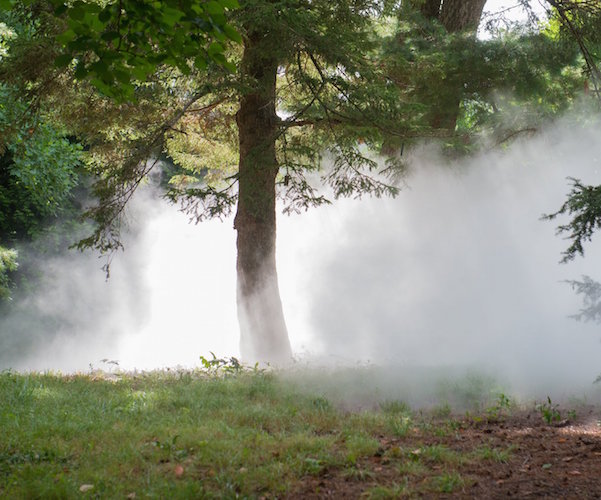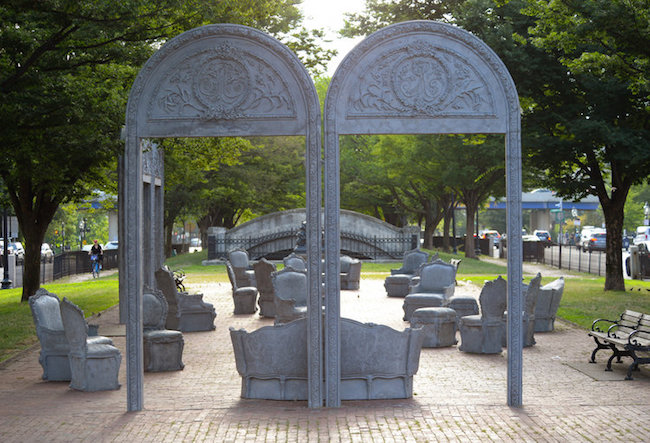Visual Arts Commentary: Three Temporary Public Art Pieces — A Dialogue with Art and Ourselves
Three bold new public art installations underscore the possibilities of visual and conceptual experiences in 21st century Boston.
Fog x FLO can be viewed through October 31.
Autumn (…Nothing Personal) through Oct. 1.
Open House is being exhibited through November 4.

“Fog x FLO” by Fujiko Nakaya. Photo: Melissa Ostrow.
By Mark Favermann
Three wonderful innovative public art installations are now being showcased in the Boston area. They are free, temporary exhibitions, engaging people in meaningful experiences that encourage interactions with art that are culturally layered as well as visually compelling. The trio underscore the rich possibilities for the presentation of art in 21st century Boston.
These public art pieces are particularly meaningful considering that, historically, Boston has been regrettably conservative, even unforgivably timid, when it comes to commissioning and hosting contemporary visual experiences. Much of the blame for the stodginess should be directed at the city’s prejudice for figurative art, along with other long-running biases, from its less than cutting-edge museums and endemic non-visual zeitgeist.
Up until the last quarter of century or so, there have been very few forays into art that makes use of new media or transforms the environment. This made Boston something of a backwater when it comes to funding large public visual art statements. Ironically, this was true even though over the years there have been many creative practitioners of public art who lived and worked in the Boston area. But wonderfully, the situation has now changed. And, in the case of these particular artworks, gifted women are leading the way.
With Fog x FLO, Japanese artist Fujiko Nakaya responds to the landmarked waterways and landscapes of the Emerald Necklace, designed by the venerated Brookline-based landscape architect Frederick Law Olmstead. Nakaya’s shape-shifting, vapory forms invite visitors to immerse themselves in art while at the same time experiencing nature from different perspectives. This complex encounter encourages an enhanced appreciation of the significance of the Emerald Necklace in our city’s environmental and cultural history.
Nakaya has a long career making use of approaches that draw on new media. Since the ’70s, working with the medium of fog, she has experimented with the viewer’s experience ‘being lost’ in fog that surrounds and then dissipates. Serving up a strong counterpoint to Trump’s rejection of climate change, she strives to cultivate a reverence for nature while underscoring the cycle of life and death.
Interestingly, in 2002 she acted as a consultant to architects Diller + Scofidio on Blur Building, which was created for the Swiss Expo 2002 on Lake Neuchâtel in Yverdon-les-Bains. This environmental artpiece was the largest “structure” that the two architects built together — before their design for Boston’s ICA.
Nakaya says that she doesn’t set out to create images with her fog sculptures. Instead, the fog acts as a kind of ‘converter’ that reacts to the local meteorological conditions. Though we can’t ‘touch’ the swirls of fog, they highlight nature’s contours — somehow the environment becomes more visceral to the viewer with the addition of greater obfuscation.
Organized by the Emerald Necklace Conservancy and curated by Jen Mergel, Fog x FLO can be viewed every day and several times an hour from 8 a.m. to 7 p.m.. The work also can be navigated by a mobile web application at fogxflo.info.

“Autumn (…Nothing Personal)” by Teresita Fernandez, Photo by Jon Chase, Harvard staff Photographer
Autumn (…Nothing Personal) is a public art installation by conceptual and environmental artist Teresita Fernández. Set in Tercentenary Theatre in Harvard Yard, this vibrant installation is a labyrinth-like structure made up of three concentric circles. They are constructed of thousands of custom-made polycarbonate tubes extending vertically from the back of a series of wooden benches. Each tube is pin-striped with orange and yellow lines. Rising ten feet tall, they create a shimmering, dynamic effect that optically illuminates (and enlivens) the Yard and its surrounding canopy of trees.
The project is in part inspired by American novelist and social critic James Baldwin’s 1964 text, “Nothing Personal” published at the height of the Civil Rights Movement. Baldwin’s essay, originally produced with images by photographer Richard Avedon, explored the complex cultural and racial contradictions of the American experience, providing a critique of a dysfunctional society that is routinely unjust and violent. Still, Baldwin ends his work speaking of both love and trust.
Fernández takes Baldwin’s “Nothing Personal” as an inspiration for a public art piece that is culturally and politically layered — it is a physical site that encourages unscripted conversation among visitors. The work visually dazzles, yet it also makes us think about our troubled history in the context to our uncomfortable present. Sitting in America’s oldest university, the piece manages to be both quiet and bold — its ambiguity ironically mirrors our history, institutions, and society.
During America’s Gilded Age, New England’s wealthy elite gathered in opulent private salons and ballrooms to define their social status. These luxurious gathering spaces in Boston were the seats of considerable social power and political privilege. Open House, an installation created by Los Angeles-based, Boston-born artist Liz Glynn (organized by Now + There), cleverly comments on this class-bound period of have and have-nots. She converts former elite opulence into a site of democratic open space.

“Open House” by Liz Glynn. Photo provided by Now + There.
Open House was first presented at Doris C. Freedman Plaza in Central Park, New York. Adjacent to Kenmore Square, this new installment of the piece places an open air ruin of a ballroom into Commonwealth Avenue Mall West. The materials for the social affairs have been discarded; these once opulent chairs, sofas, and pillars are now made of concrete. The artist succeeds at highlighting class distinctions and the shifting dynamics of public and private space — an enclosed space reserved for the white and wealthy is now open to all. These “room furnishings” beckon the viewer to be seated and linger, the ghostly comforts of the past have become aesthetically tangible.
Coming while Boston is undergoing rapid development, Open House enters our current political conversation about economic inequality. Glynn’s desire is to incite re-action and to inspire thoughtful future action.
Each of these three temporary environments places social, cultural, and ecological concerns in a historic context. From using fog mist to giant glow-sticks and concrete furniture, the artists explore distinctive artistic approaches, materials, and expressions of concern. Their works challenge us to look at, meditate on, and even empathize with the problems or propositions that they present.
One can go even further. Today’s distinctions among artist as curator, artist as activist, and site as artwork (with their many combinations and permutations) are beginning to break down. Each of these three artworks is not just a work of visual art, but should be appreciated as a poem writ large.
An urban designer and public artist, Mark Favermann has been deeply involved in branding, enhancing, and making more accessible parts of cities, sports venues, and key institutions. Also an award-winning public artist, he creates functional public art as civic design. Mark created the Looks of the 1996 Centennial Olympic Games in Atlanta, the 1999 Ryder Cup Matches in Brookline, MA, and the 2000 NCAA Final Four in Indianapolis. The designer of the renovated Coolidge Corner Theatre, he is design consultant to the Massachusetts Downtown Initiative Program. He has been a design consultant to the Red Sox since 2002. Mark is Associate Editor of Arts Fuse.
Tagged: Autumn (…Nothing Personal), Boston public art installations, Fog x FLO, Mark Favermann
